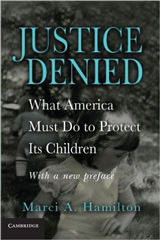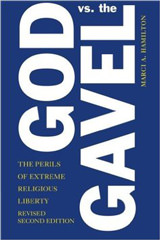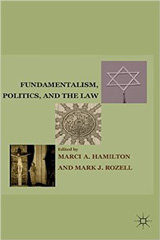A pillar of the contemporary conservative movement is hostility to the separation of church and state. For much of the movement, it’s not just that church and state should be tight partners but also that the United States is and should be a Christian country. Their aims have been achieved to a significant degree with the latest decision from the Supreme Court on public displays of religious symbols, American Legion v. American Humanist Association. While ostensibly a decision limited to the government’s support of an old, overbearing Latin cross at a small traffic intersection, a majority of the Court goes out of its way to chart a new path toward erasing the separation of church and state.
Their aim is to turn the Establishment Clause into a prop for religious freedom, which in this era is actually a euphemism for power over the culture. They utterly ignore that the history of the Establishment Clause was to create a bulwark against the tyranny that results from the joinder of government and religious power to rule.
A Cross Starts as a Private Memorial and Becomes the Government’s
There is no debate that a private entity could have established and maintained this Latin cross on private property under the First Amendment. In fact, in 1918 private forces did in fact commission, fund, and establish the 32-foot cross on private land. They created it to honor the fallen in World War I. Private individuals and organizations donated to the project.
Enter the government and the First Amendment. In 1961, the government took it over, the space where it is planted became a small and busy traffic intersection, and the government has spent over $100,000 maintaining it. This towering symbol of Christian faith was now the government’s, so the American Humanist Association in this era rightly asked whether this is an appropriate role for the government. They filed a lawsuit, lost at the trial level and won in the Fourth Circuit. Under existing Supreme Court precedent, the Fourth Circuit should have been affirmed. It was not, and a majority of the Court went out on a limb to make clear that prior precedent is no longer controlling.
Their theory was based on Justice Sandra Day O’Connor’s important contribution to Establishment Clause jurisprudence, the “endorsement test.” The endorsement test was developed as an elaboration of the “effect” factor from Lemon v. Kurtzman, or as it became known, the “Lemon test.” They argued that the government support of this specific, undeniably Christian symbol is offensive to them and that it is barred by precedent. Likewise, Jewish war veterans filed an amicus brief saying that they saw the cross on public land as a message of exclusion. One can understand their point. As the majority points out, the graves of those who died in WWI were marked with either a cross or a star of David. Yet, this is a huge cross all by itself.
The majority actually rubs salt in the wounds of the Jewish war vets by more than once justifying this cross as a memorial, because there were famous photos of rows of white crosses following WWI. That’s right—they acknowledge that there were Christian and Jewish graves with their particular religious markers and that the culture at the time solely focused on the Christian symbols. Once marginalized is not enough apparently.
Justice Kavanaugh, who wholeheartedly joins the majority and plurality, also makes a point in his separate opinion of noting the Jewish war veterans’ amicus brief to “recognize their sense of distress and alienation,” but then he tells them to go to the state legislature to get the cross removed. In other words, if the government prefers a religious symbol and you feel excluded, go get yourself some political relief. Don’t expect the justices to take that into account when they are interpreting the Establishment Clause.
For the Fourth Circuit, the remedy, consistent with the prior case law, was to either have it removed or to add other symbols in the area to make it more inclusive. Now the remedy for an unholy union of power between church and state is, well, political.
At a time in history when the proliferation of diversity among believers is at an all-time high and when younger generations increasingly are “Nones,” which is to say unaffiliated with a specific organized religion, Justice O’Connor’s endorsement test was a brilliant way to ensure that the government remains neutral among the many contenders for its attention and favor, and that the disenfranchisement felt by those not part of the dominant religious culture be taken into account. Yet, her endorsement test has been hated and reviled by conservative jurists; it created a barrier to the Christian country agenda and the goal of replacing the separation of church and state with an Establishment Clause doctrine limited to proactive support for religion.
The New Doctrine: Abandon Lemon, and Perhaps the Cases that Limit the Power of Religion to Govern
There are six votes in this case to put the Lemon test to rest, which means it is now overruled even if they did not use the term itself. A plurality of the Court (Chief Justice Roberts and Justices Alito, Breyer, and Kavanaugh) heavily criticized the Lemon test and introduced for cases such as this one a “presumption of constitutionality for longstanding monuments, symbols, and practices.” In other words, they abandoned Lemon.
Those four justices were joined by Justices Gorsuch and Thomas in their intent to overrule Lemon. In case the reader was not counting all the votes to inter Lemon and the attendant endorsement test, Gorsuch stated in his concurrence in the judgment: “With Lemon now shelved, little excuse will remain for the anomaly of offended observer standing. . . .”
Note that the three female members of the Court would preserve the Lemon test, and its appeal to consider whether a citizen feels disenfranchised by the government’s support of religion. It does not take a scientific study to understand that these women have experienced such feelings while the other members of the Court cavalierly assume the righteousness of the majoritarian, historic, and traditional.
As a side note, Gorsuch and Thomas would go even farther than the adoption of a presumption of constitutionality for longstanding monuments and even deny standing to litigants in most Establishment Clause cases, particularly ones involving religious imagery. In a separate concurrence, Thomas also reiterated his longtime argument that the Establishment Clause should not apply to local and state governments; in other words, states and cities should be able to establish religion as they see fit.
Now that Lemon is history, we are left to ask what is next. The plurality introduced a new taxonomy of the Establishment Clause. After criticizing the Lemon test, they drop footnote 16 in which they list “six rough categories” for Establishment Clause cases, essentially (1) symbols, (2) religious exemptions, (3) subsidies and tax exemptions, (4) religious expression in public schools, (5) regulation of private religious speech, and (6) state interference with internal church affairs.
Here is what proves that the agenda of a majority of the justices is to empower religion, diminish the separation of church and state, and to tear down barriers to religious power. The plurality adds to the six categories a “miscellaneous category,” as though these cases are not really legitimate. They say that cases involving Sunday closing laws and “church involvement in governmental decisionmaking . . . might be added” to their list. The strong implication is that they doubt the legitimacy of those cases. What do these cases hold? That religion may not define the public calendar and that a religious entity may not exert governing power.
The landmark government power cases are Larkin v. Grendel’s Den and Board of Ed. of Kiryas Joel Village School Dist. v. Grumet. Larkin held that a church cannot be the decisionmaker whether a bar is zoned for a license, and Kiryas Joel held that a school district cannot be drawn solely according to the identity of a religious sect. Kavanaugh in a separate opinion completely leaves out this last category of cases. This move to sideline these cases is an alarming development for anyone who knows the history of a union of power between government and religion.
James Madison on the Error of Letting Religion Rely on Government for Support
James Madison fundamentally understood the dangers of investing religion with political authority and government support in his famous Memorial and Remonstrance:
Because experience witnesseth that ecclesiastical establishments, instead of maintaining the purity and efficacy of Religion, have had a contrary operation. During almost fifteen centuries has the legal establishment of Christianity been on trial. What have been its fruits? More or less in all places, pride and indolence in the Clergy, ignorance and servility in the laity, in both, superstition, bigotry and persecution. Enquire of the Teachers of Christianity for the ages in which it appeared in its greatest lustre; those of every sect, point to the ages prior to its incorporation with Civil policy. Propose a restoration of this primitive State in which its Teachers depended on the voluntary rewards of their flocks, many of them predict its downfall. On which Side ought their testimony to have greatest weight, when for or when against their interest
The Establishment Clause is Madison’s handiwork and a major bulwark against tyranny when the justices treat religion as not just a force for good but also a potential source of political corruption and self-dealing. The Supreme Court is in need of a strong dose of Madison before it ushers in an era of Christian theocracy.









